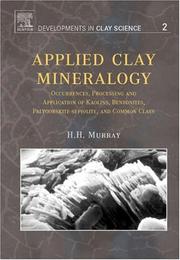| Listing 1 - 10 of 187 | << page >> |
Sort by
|
Book
Abstract | Keywords | Export | Availability | Bookmark
 Loading...
Loading...Choose an application
- Reference Manager
- EndNote
- RefWorks (Direct export to RefWorks)
Book
Year: 1963 Publisher: Paris : Masson,
Abstract | Keywords | Export | Availability | Bookmark
 Loading...
Loading...Choose an application
- Reference Manager
- EndNote
- RefWorks (Direct export to RefWorks)
Book
Year: 1968 Publisher: New York (N.Y.) : McGraw-Hill,
Abstract | Keywords | Export | Availability | Bookmark
 Loading...
Loading...Choose an application
- Reference Manager
- EndNote
- RefWorks (Direct export to RefWorks)
Book
ISBN: 3929907313 Year: 1996 Publisher: Frankfurt am Main Senckenbergische naturforschende Gesellschaft
Abstract | Keywords | Export | Availability | Bookmark
 Loading...
Loading...Choose an application
- Reference Manager
- EndNote
- RefWorks (Direct export to RefWorks)
Book
Year: 2015 Publisher: Amsterdam, [Netherlands] : Elsevier,
Abstract | Keywords | Export | Availability | Bookmark
 Loading...
Loading...Choose an application
- Reference Manager
- EndNote
- RefWorks (Direct export to RefWorks)
Clays are used as barriers for the isolation of landfills and contaminated sites. They are envisioned as long-term storage media for hazardous materials and radioactive wastes, and as seals in the case of geological CO2 sequestration or energy storage. Clay properties greatly influence the integrity, efficiency, and safety of these applications. Natural and Engineered Clay Barriers provides a clear view of the fundamental properties of clay materials and how these properties affect their engineering applications. This volume focuses on how the mass transfer properties (hydraulic permeability, gas fluxes, molecular diffusion, semi-permeable membrane properties), geochemical reactivity (adsorption, dissolution) and mechanical properties of clay barriers at the macroscale are influenced by phenomena that occur at clay mineral - water interfaces. Examines clay properties from the molecular to the macroscopic scale Addresses experimental and modeling issues Authored by experts in the properties of clay barriers.
Book
ISBN: 1536168130 9781536168136 Year: 2020 Publisher: New York : Nova Science Publishers,
Abstract | Keywords | Export | Availability | Bookmark
 Loading...
Loading...Choose an application
- Reference Manager
- EndNote
- RefWorks (Direct export to RefWorks)
"Halloysite is a natural clay mineral that belongs to the kaolin group. Its chemical formula is Al2(OH)4Si2O5.nH2O. Primarily, this mineral is an ideal nanofiller for polymer composites, but it is also utilized in the manufacture of ceramic wares and in the encapsulation of drugs in the pharmaceutical industry. The authors present details regarding a simple, rapid, high-yield, and low-temperature synthetic approach for the in-situ growth of noble metal nanoparticles in the interior of halloysite nanotubes. Benefits of halloysite nanotubes for polymeric structures and technical applications in various fields are highlighted, particularly their thermal stability, mechanical strength, and non-flammability. The closing chapter focuses on the latest research concerning halloysite nanotubes applications in different fields such as biomedicine and pharmacotherapy, food packaging, agriculture, water treatment, catalysis and antifouling"--
Book
Year: 2015 Publisher: Amsterdam, [Netherlands] : Elsevier,
Abstract | Keywords | Export | Availability | Bookmark
 Loading...
Loading...Choose an application
- Reference Manager
- EndNote
- RefWorks (Direct export to RefWorks)
Clays are used as barriers for the isolation of landfills and contaminated sites. They are envisioned as long-term storage media for hazardous materials and radioactive wastes, and as seals in the case of geological CO2 sequestration or energy storage. Clay properties greatly influence the integrity, efficiency, and safety of these applications. Natural and Engineered Clay Barriers provides a clear view of the fundamental properties of clay materials and how these properties affect their engineering applications. This volume focuses on how the mass transfer properties (hydraulic permeability, gas fluxes, molecular diffusion, semi-permeable membrane properties), geochemical reactivity (adsorption, dissolution) and mechanical properties of clay barriers at the macroscale are influenced by phenomena that occur at clay mineral - water interfaces. Examines clay properties from the molecular to the macroscopic scale Addresses experimental and modeling issues Authored by experts in the properties of clay barriers.

ISBN: 9780444517012 0444517014 9780080467870 0080467873 1280747102 9786610747108 Year: 2007 Publisher: Boston : Elsevier,
Abstract | Keywords | Export | Availability | Bookmark
 Loading...
Loading...Choose an application
- Reference Manager
- EndNote
- RefWorks (Direct export to RefWorks)
This book on Applied Clay Mineralogy is comprehensive. It covers the structure, composition, and physical and chemical properties of kaolinite, halloysite, ball clays; bentonites including sodium montmorillonite, calcium montmorillonite, and hectorite; and palygorskite and sepiolite. There is also a short chapter on common clays which are used for making structural clay products and lightweight aggregate. The location and geology of the major clay deposits that are marketed worldwide and regionally include kaolins from the United States, Southwest England, Brazil, and the Czech Republic alon
Clay minerals. --- Clay minerals --- Industrial applications.
Book
ISBN: 9630519895 Year: 1981 Publisher: Budapest : Akadémiai Kiadó,
Abstract | Keywords | Export | Availability | Bookmark
 Loading...
Loading...Choose an application
- Reference Manager
- EndNote
- RefWorks (Direct export to RefWorks)
Book
ISBN: 9781621003120 1621003124 9781621002406 1621002403 Year: 2012 Publisher: Hauppauge, N.Y. : Nova Science Publishers,
Abstract | Keywords | Export | Availability | Bookmark
 Loading...
Loading...Choose an application
- Reference Manager
- EndNote
- RefWorks (Direct export to RefWorks)
| Listing 1 - 10 of 187 | << page >> |
Sort by
|

 Search
Search Feedback
Feedback About UniCat
About UniCat  Help
Help News
News